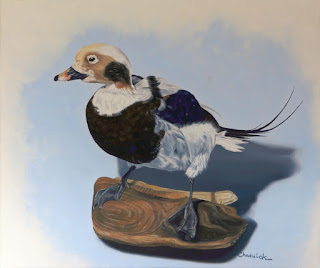I would have just turned 18 and was about to go into Grade Thirteen at the Brockville Collegiate and Vocational School - BCIVS. I was also a yard keeper at St Lawrence Lodge.
This painting is from a wood carving owned by Mario Airomi. Mario said something about this being a copy of a famous work but I honestly forget the details. A cherub is traditionally a winged angelic being described in biblical terms as attending on God. There are many different depictions of cherubs and those relate to their different roles in supporting God. The original duty of the cherubs was the protection of the Garden of Eden. Apparently they failed miserably at that task. These two cherubs appear to have been on holidays.
It was my fifth oil painting and I was still practicing. This time there was some colour introduced to the subject. - a big step up from the mainly monochromatic clay sculptures. This painting hung in the entry of my parents place for decades.
This painting is from a wood carving owned by Mario Airomi. Mario said something about this being a copy of a famous work but I honestly forget the details. A cherub is traditionally a winged angelic being described in biblical terms as attending on God. There are many different depictions of cherubs and those relate to their different roles in supporting God. The original duty of the cherubs was the protection of the Garden of Eden. Apparently they failed miserably at that task. These two cherubs appear to have been on holidays.
It was my fifth oil painting and I was still practicing. This time there was some colour introduced to the subject. - a big step up from the mainly monochromatic clay sculptures. This painting hung in the entry of my parents place for decades.




























